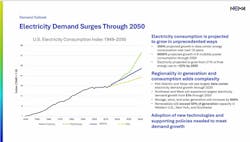U.S. government policies – on trade, re-shoring of industry, taxation and regulation – will be critical to improving electrical grid reliability, the subject of a new study by the National Electrical Manufacturers Association (NEMA) that happens to coincide with a potentially epic policy upheaval.
Unveiling the new research in an April 4 webinar that came on the heels of the Trump administration’s ground-shaking tariffs announcement, NEMA called for an approach that would help ensure short- and long-term access to products that will be needed to build out and bolster the nation’s power grid.
Fielding questions on how tariff and tax policies might color the study’s findings, NEMA president and CEO Debra Phillips said the industry supports the administration’s focus on rebuilding domestic manufacturing but needs to recognize that it will take time.
“We’ve been doing this ourselves in our industry, with a $185-billion investment in U.S. manufacturing, but we’d like the administration to understand the need for a transition period to bring those supply chains back to the U.S.,” Phillips said.
Until that transition can happen, to whatever degree possible, the industry will need a high degree of supply chain certainty and predictability, Phillips said. Being able to freely tap into Mexican and Canadian suppliers as well as those in the U.S., via the United States-Mexico-Canada Agreement, will be especially important.
“This administration is behind grid reliability, and our industry will play a supporting role in all of that,” she added.
The NEMA study New Study Highlights Urgent Need to Prioritize Grid Reliability to Meet Surging Electricity Demand - NEMA, “A Reliable Grid for an Electric Future,” projects relentless rising U.S. demand for electricity that will have to be met with a mix of added generation, storage and transmission capacity and efforts to improve efficiency, reliability and resiliency. Demand is projected to grow 50% over the next 25 years — a rise that will be supercharged by demand from data centers and electrified transportation. By 2050, the study estimates, electricity will account for 32% of final energy usage, up from 21% currently (see chart below).
Outfitting the grid, and everything that attaches to it, to handle that demand and improve resiliency and reliability will rely heavily on hard products, in addition to digital control resources. From electrical grade steel, transformers, batteries and advanced conductors to industrial motors, advanced lighting controls, electric vehicle chargers and uninterruptable power supplies, equipment sourced across the globe by NEMA members will be central to achieving the degree of grid capability and resiliency the study envisions.
Several NEMA members joining the webinar panel weighed in on the industry’s critical role.
Michael Plaster, executive vice president and lead business manager for the U.S. electrification business of Switzerland-based ABB Inc., said expected growth in demand related to grid enhancement for its products is spurring intense focus on the supply chain. “Local for local,” is the byword, he says, short for shortening supply chains globally.
While digitalization of the grid will play a key role, products like variable-speed drives that make motors more efficient, circuit breakers for power reliability and electrical distribution equipment will be in high demand as grid resiliency grows in importance, intensifying the need for reliable supply. ABB has initiated new rounds of investment in U.S. production capacity, which meets more than 75% of the company’s U.S. demand. “Our customers expect certainty of supply,” Plaster said.
Rich Stinson, President and CEO of Southwire, a Carrolton, Ga., wire and cable manufacturer, forecasts growing demand for advanced transmission line reconductoring solutions that help on the efficiency improvement side of the grid challenge. Growth in that area, along with others like coatings that improve transmission line emissivity, has justified another round of investment totaling around $2 billion, Stinson says.
Supplier ability to meet the demands of the all-out war on grid insufficiency the NEMA study calls for, though, may hinge on what happens in the nation’s capital. Policy writ large, the study suggests, will help determine the speed, nature, cost, and success of such an endeavor. Consistent trade policies; supply chain certainty; permitting and transmission reforms; tax certainty; backing of an “all-of-the-above” approach; and skilled energy workforce development are parts of that puzzle — one that could become harder to piece together.
About the Author
Tom Zind
Freelance Writer
Zind is a freelance writer based in Lee’s Summit, Mo. He can be reached at [email protected].

